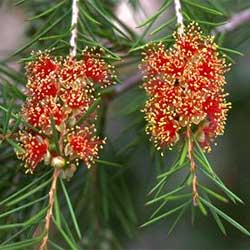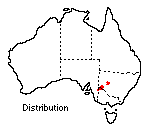Callistemon brachyandrus
Also known as Melaleuca brachyandra
 |
Prickly Bottlebrush
Callistemon brachyandrus Lindl.
The Prickly Bottlebrush (Callistemon brachyandrus) is an easily cultivated species. It is found growing naturally on a wide range of soil types in western New South Wales, Victoria, and South Australia. In the Australian National Botanic Gardens it forms a large bushy shrub growing to a height of 2m - 3 m with a spread of 3m - 4 m. In nature it achieves 4m x 4m.
 During
the summer months, after most other Callistemon species have flowered,
small red brushes up to 8 cm long cover the branches. The masses of stamens,
which are the conspicuous parts of the flowers, are dark red with yellow anthers.
These two characters combine to give the flowers the appearance of being dusted
with gold. The five small petals and sepals, together with the pistils, are
barely noticeable among the showy stamens.
During
the summer months, after most other Callistemon species have flowered,
small red brushes up to 8 cm long cover the branches. The masses of stamens,
which are the conspicuous parts of the flowers, are dark red with yellow anthers.
These two characters combine to give the flowers the appearance of being dusted
with gold. The five small petals and sepals, together with the pistils, are
barely noticeable among the showy stamens.
Like so many of Australia's attractive native plants the inflorescence of Callistemon is composed of large numbers of small flowers grouped together. The flower arrangement in Callistemon closely resembles a bottle cleaning brush, hence the common name Bottlebrushes.
The stiff, sharp-pointed leaves are much smaller and narrower than other Callistemon species, being only 1.5 - 4 cm long and 1 mm wide. The undersurfaces of the linear leaves are typically dotted with oil glands. The young shoots are quite soft and hairy, much different from the mature needle-like foliage. This lush growth adds a very attractive greyish appearance to the shrub.
After flowering, pruning is beneficial in maintaining a healthy bushy shrub. Pruning need only consist of the removal of dead flower spikes and general shaping. The fruit is a woody three-celled capsule, 5 - 7 mm in diameter. New plants can be readily propagated from seed. For propagation, collect the oldest fruits possible, and place them in a paper bag. Once the capsules have dried sufficiently they will open, releasing many tiny seeds. The process of drying out the capsules can be accelerated by placing them in a warm sunny position. Tip cuttings of new season's growth can also be used as a means of producing additional plants.
Like other Callistemon species, C. brachyandrus species has the ability to cope with poor drainage, growing equally well on wet or dry soils. It does, however, prefer full sun. Many Callistemon species suffer from occasional attacks by scale insects, thrips and sawfly larvae. These three pests can cause considerable damage to the foliage. Thrips and scale insects badly disfigure the leaves and sawfly larvae can defoliate some species. C. brachyandrus has proved to be generally resistant to attack by these insects. If these pests should occur on this or other Callistemon species a horticultural adviser should be consulted for recommendations on methods of control in your area.
Text by ANBG staff (1975)
Name meaning: Callistemon brachyandrusCallistemon - from two Greek words, kallistos, most beautiful, and stemon, a stamen; brachyandrus - a Greek compound meaning short stamens from brachy , short, and andrus, adjectival form of anthropos, man |
![An Australian Government Initiative [logo]](/images/austgovt_brown_90px.gif)

